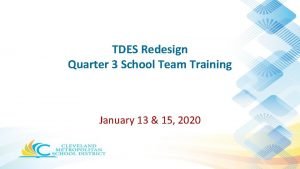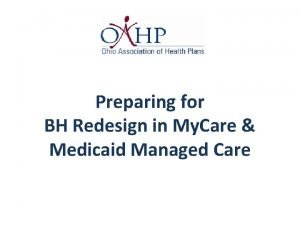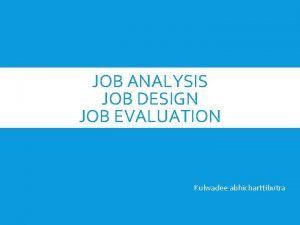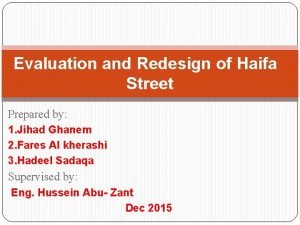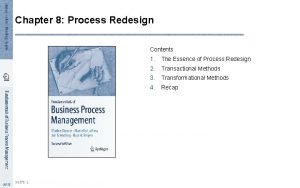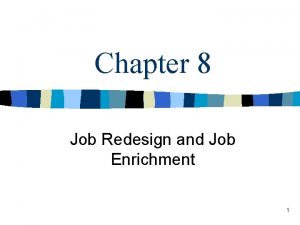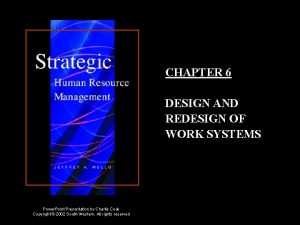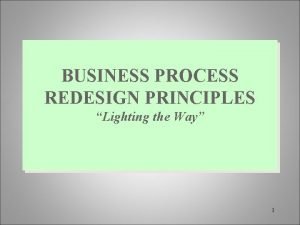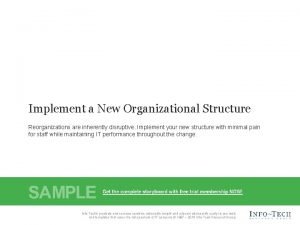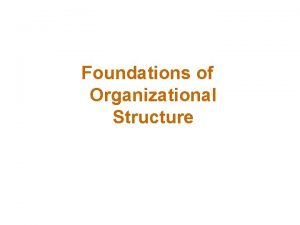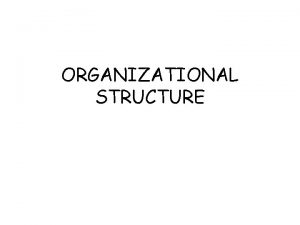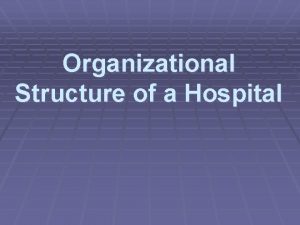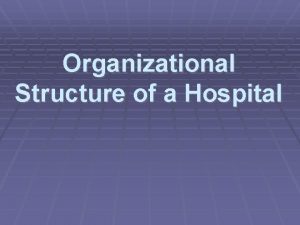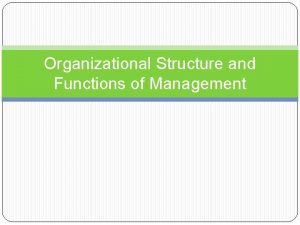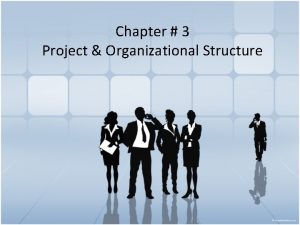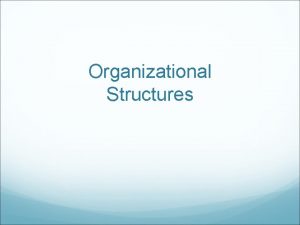Redesign Your IT Organizational Structure Reorganizations are difficult












- Slides: 12

Redesign Your IT Organizational Structure Reorganizations are difficult to get right. Take a strategic approach that provides operational stability in the now and flexibility for the future. Info-Tech Research Group Inc. is a global leader in providing IT research and advice. Info-Tech’s products and services combine actionable insight and relevant advice with Info-Tech's products and services combine actionable insight and advice ready-to-use tools and templates that cover the fullrelevant spectrum of IT with concerns. and templates that cover the full spectrum IT concerns. © 1997 -2020 Info-Tech Group © of 1997 -2018 Info-Tech Research Group Research Inc. Info-Tech Research Group 1

Our understanding of the problem This Research Is is Designed For: This Research Will Help You: üCIOs üRestructure the IT organizational design to be optimized to the IT strategy. üSelect an appropriate operating model and organizational structure, and customize it to fit your unique organization. üDetermine future-state roles and responsibilities. üDevelop an effective communications plan to get buy-in from business and IT stakeholders. This Research Will Also Assist: This Research Will Help Them: You: üIT Leaders üBecome champions of the change, helping to promote the change to other employees. üAnticipate employee concerns and plan to mitigate them and gain buy-in. üUnderstand their new roles and responsibilities in the organization. Info-Tech Research Group 2

Executive summary Situation • Organizational design is the alignment of organizational structure, roles, • and processes to execute on business strategy – the better aligned the organization is, the more effective it is. For optimal results, the structure of the IT organization must match its strategy, but often IT organizations grow to meet needs of the day and not by strategic design. Complication • Redesigning your IT organization can be highly disruptive, emotional, and • politically charged. Effective reorganization efforts need to start with identifying future direction, defining a future operating model, and making difficult decisions about how you will deliver IT services in the future. For organizations that have attempted a reorganization in the last two years, 77% of those have failed (Aronowitz et al. ). 1. Structure follows strategy – how your organization is designed will dictate how it behaves. It is the key enabler of your strategic direction. 2. Focus first on capabilities. Build a forward-looking operating model first – then look to people and roles. 3. Change in practice, not just on paper. Redesign requires constant caring and feeding to see it through to the finish line. Resolution This blueprint will walk you through the organizational redesign process, providing a strategic methodology to customize your future-state structure to specific organizational nuances and strategic imperatives, while remaining flexible to future change. 1. Define a set of organizational design principles that will help to ensure the structure aligns with strategy. 2. Visualize IT’s structure with a customized operating model, clearly demonstrating how IT creates value and how work flows in and out of the department. 3. Define future-state work units, roles, and responsibilities that will enable the IT organization to complete the work that needs to be done. 4. Craft a communications plan that will address key stakeholder concerns and maintain ongoing buy-in for the new structure. Info-Tech Research Group 3

IT organization design is the means to enabling IT’s strategic direction What is IT organizational design? IT organizational design refers to the process of aligning the organization’s structure, processes, metrics, and talent to the organization’s strategic plan in order to drive efficiency and effectiveness. If your IT strategy is your map, your IT organizational design represents the optimal path to get there. Why is the right IT organizational design so critical to success today? Adaptability is at the core of staying competitive today Digital technology and information transparency are driving organizations to reorganize around customer responsiveness. To remain relevant and competitive, your organizational design must be forward looking and ready to adapt to rapid pivots in technology or customer demand. Structure is not just an organizational chart The design of your organization dictates how roles function. If not aligned to the strategic direction, the structure will act as a bungee cord and pull the organization back toward its old strategic direction (Morales Pedraza). Structure supports strategy, but strategy also follows structure. Organizational design is a neverending process Organization design is not a onetime project, but a continuous, dynamic process of organizational self-learning and continuous improvement. Landing on the right operating model will provide a solid foundation to build upon as the organization adapts to new challenges and opportunities. Info-Tech Research Group 4

Organizational design is the mechanism for how you enable your strategy and priorities The organization’s choice of strategy and the tactics to realize that strategy will have a direct impact on how the internal organization should be organized. This means that you need an iterative process to reassess organizational design at regular intervals. As governance decisions lead to changes in strategic direction, the supporting structures need to be reassessed to ensure they are still aligned. IT STRATEGY IT GOVERNANCE The identification of organizational objectives, principles, and tactics necessary to drive business value. A body that has the responsibility and authority for approving strategic direction and monitoring performance. ORGANIZATIONAL DESIGN The operating model and architecture for how IT is organized to deliver on business needs and strategies. Info-Tech Research Group 5

Many organizations are going through organizational redesigns, but few are getting it right 60% Of companies have attempted an organizational redesign in the last 2 years YET… 77% Of those org designs FAIL. Source: Aronowitz et al. Why is it so difficult to succeed at IT organizational redesign? 1 Many organizations change the structure on paper, but not in practice. Organizational design efforts are not complete without long-term dedication to creating a shift in culture and practice. 2 Organizations look to force fit a “trendy” structure. Many organizations attempt to force fit an organizational structure they want to work with rather than picking a structure that enables its strengths and goals or truly will work for their culture. 3 Restructuring IT impacts much more than IT. Without the right strategic approach, managing the diverse and complex opinions from business stakeholders can prove cumbersome. The redesign process must be as inclusive as possible to parties affected by the change. Info-Tech Research Group 6

86% of IT leaders believe organization and leadership processes are critical, yet the majority struggle to be effective GAP BETWEEN IMPORTANCE AND EFFECTIVENESS PERCENTAGE OF IT LEADERS WHO BELIEVE THEIR ORGANIZATION AND LEADERSHIP PROCESSES ARE HIGHLY IMPORTANT AND HIGHLY EFFECTIVE 45% Organizational Design 61% Human Resources Management Organizational Change Management 55% 0% High Importance 50% 100% High Effectiveness Note: Importance and effectiveness were determined by identifying the percentage of individuals who responded with 8 -10/10 to the questions: • “How important is this process to the organization’s ability to achieve business and IT goals? ” • “How effective is this process at helping the organization to achieve business and IT goals? ” Source: Info-Tech Research Group Management and Governance Diagnostic N=22, 800 IT Professionals Info-Tech Research Group 7

The way your organization is built dictates how it will perform. Are you set up for success? 52% of IT organizations self-identify as being in firefighter mode. This means they are focused on resolving urgent or recurring IT issues to achieve short-term gains, rather than spending time on strategic goals. As a result of this firefighting mentality, most structures today are not consciously built – they’ve arisen organically, unguided by a long-term vision. These Band-Aid solutions can work temporarily, but ultimately organizations end up with structures that are ill equipped to meet the strategic needs of the future. The design of your IT organization has a significant impact on how it performs. Where you invest in staffing, the level of hierarchy, and the way you manage your relationships with the business have a significant impact on what gets done, when it gets done, how it gets done, and what the business thinks about it. Every structure decision you make should be based on an identified need, not on a trend. Build your IT organization to enable the priorities of the organization. Effective organizational design is a competitive advantage. By designing the structure with your business and IT goals in mind, you can build a department that enables these goals – and ensure that you are spending money and resources on the most important things. Info-Tech Research Group 8

Use Info-Tech’s methodology to set yourself up for success Top factors of organizational design success 1 1 2 2 3 4 4 6 Synchronize design with strategy Clarify roles and responsibilities Design layer by layer Don’t wait for a crisis Source: The Boston Consulting Group Increased odds of success How Info-Tech’s methodology addresses these factors: 5 x Your IT strategy will serve as one of the key inputs into crafting a set of organizational design principles that will guide the design of your future-state organizational structure. 6 x Conduct a comprehensive RACI chart that will clarify which roles are accountable and responsible for each of your IT capabilities. This will ensure clarity over the way in which work is done, and who needs to collaborate with who. 4 x Start with an operating model, overlay your core IT capabilities, and then structure your organizational sketch based on groupings of those IT capabilities and on the work that needs to be done. 21 x By using targeted design principles to craft a baseline operating model for the IT organization, it enables you to be proactive and integrative in rationalizing upcoming change and integrating it into your IT organization structure. Info-Tech Research Group 9

The following organizational design challenges can be avoided through structured planning This research is designed to help small to medium-sized organizations across different market segments successfully transform their organizational structure. Assess your fit for this blueprint by considering if the below statements sound familiar: q You haven’t actively planned your structure – it just “happened. ” q Your business complains that IT doesn’t understand their needs. q Your structure is outdated and the business strategy or goals have changed since the last time a redesign initiative occurred. q You need to add new capabilities into the IT organization. q Your organization is growing and IT cannot keep up. q Your business units have highly divergent needs and IT can’t keep up. q Your CEO is mandating a change in IT. q Your staff is being asked to do work outside of what is in their job descriptions, wasting time on activities that shouldn't be their responsibility. q You are experiencing work duplication, role conflict between members of the IT team, and/or inefficiencies. q You’re spending too much time on the wrong things. q You have noticed that there are high levels of redundancies that are causing delays and a lack of accountability. q You’re ready to make a transformational change to the way IT functions and performs. Info-Tech Research Group 10

Track the success of your redesign using business metrics How do I measure the success of my redesign? The purpose of your IT organizational design is to enable IT to meet its strategic objectives, which are aligned with the larger enterprise’s vision and direction. It is imperative to adapt the key performance indicators (KPIs) that the business is using to track its success and demonstrate how IT can assist the business and improve its ability to reach those targets. Examples of metrics specific to IT: Questions to ask 1. 2. What are the leading indicators of IT effectively supporting the business’ strategic direction? How are success metrics aligned with the objectives of other functional groups? • • • Percentage of resources dedicated to key capabilities Percentage of resources dedicated to strategic priorities and initiatives Overall business satisfaction with IT Are your metrics achievable? S pecific M easurable A chievable R ealistic T ime-bound While org design involves the art of the possible, it must be grounded in achievable outcomes. Ensure that the metrics your redesign is measured against reflect realistic and tangible business expectations. Overpromising the impact the organizational design will have can lead to long-term implementation challenges. Info-Tech Research Group 11

Dive Deeper Into Our Research by Clicking One of the Elements Below Find out how Info-Tech makes your job easier. Contact Us Today: Toll-Free (US & Canada): 1 -888 -670 -8889 Info-Tech Research Group 12
 Insidan region jh
Insidan region jh Getting organizational redesign right
Getting organizational redesign right Dealing successfully with difficult changes in your life
Dealing successfully with difficult changes in your life Dealing successfully with difficult changes in your life
Dealing successfully with difficult changes in your life Tdes school
Tdes school Bh redesign
Bh redesign What is job analysis
What is job analysis Coast guard bpr
Coast guard bpr Redesign haifa
Redesign haifa Redesign orbit
Redesign orbit Job redesign meaning
Job redesign meaning Design and redesign of work systems
Design and redesign of work systems Business process reengineering principles
Business process reengineering principles




